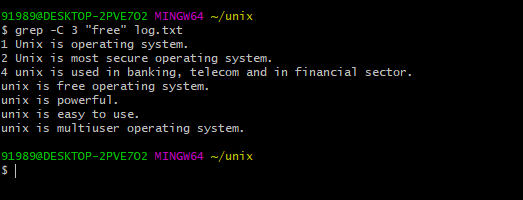
Use “CA n” to find and print the match along with “n” lines before and after the match. Use “-B n” to find and print the matches along with “n” lines before the match. Use “-A n” to find and print the matches along with “n” lines after the match. Use “-w” to find and print whole word matches. Use a combination of “-v” and “-i” to refine the search.

Use “-v” to find and print all inverse (non-matching) lines. Use a combination of “-c” and “-i” to refine the search. For example, if you wanted to find the word example in a file and get 5 lines of context before and after it, you would use the command: grep -C 5 example file.txt This would print out 5 lines of context before and after each line. Use “-c” to find and print the number of line matches. There are a few ways to get 5 lines before and after a grep search.

Use “-n” to find and print matches and include line numbers. You can specify the options in the grep environment variable.
#GREP LINES BEFORE AND AFTER HOW TO#
Before using grep, you need to know how to specify the options. This article will walk you through the command. To find these lines, you can use grep parameters to show both before and after matches. Use “-i” to ignore case ~]# grep -i world example.txt You can also see the lines before and after the matching words. -C n: Prints n lines before and after matches.Įxample: file “example.txt” contains the following 5 lines: hello worldīasic command: Find and print an exact match for “world” ~]# grep world example.txt.-v: Prints lines not matching criteria (inverse search).-c: Prints count of lines with matching criteria.

you the lines before your matches, you can add -B to your grep.
-n: Prints lines with matching criteria and line numbers. type f -print0 xargs -0 grep PATTERN For OP: I considered following. -i: Prints lines with matching criteria while ignores casing (Upper/Lowecase). You can add any of the following options individually or in combination to refine your search: This command searches for and returns any lines of text that contain the given criteria string in filename(s). the matchgrep -C 4 word file. The following example shows the basic command structure: grep 'string' filename(s) Grep stands for global regular expression print and it is a command line. Grep will print the matching string along with 5 previous lines on the console in the following command, thanks to the -B. However, we can calibrate the output to print a couple of lines before and/or after the string match. By default, grep will print the line it finds the specified string. The next step is to pipe it to a command that can print the line every time nth. Print lines before and after the matching string. We can get the n-th line before each match by first performing grep -bn, which finds all blocks with n1 lines. You can find a list of all the names by typing -nri -A 5 -B 5 into the search box. grep stands for Globally search for a Regular Expression and Print it out. SiteHow use grep command linux unix with examples nixcraft show lines before and after match via linuxcommands siteHow use grep command Linux Unix with examples nixCraftSource Lines Before and After Match via GrepSource grep. It is recommended to use grep -A (after) and -B (before). You use the grep command within a Linux or Unix-based system to perform text searches for a defined criteria of words or strings. If you want more, or different, lines, be sure to adjust both the 5 in the double-parentheses and add a -n to head.This article explains how to start using the grep command in Linux®. So, you get 10 lines, starting at 5 lines before the match. Pipe (|) the whole mess through head, which defaults to 10 lines. The second occurrence of the filename is an argument to the tail command at the beginning of the line. So, my sample subtracts 5 from the line number and that is used for the first argument to tail. If that one doesn't work for you, there are other ways to get the math done. $(( expr)) is a bashism that does some math for you. cut -d delimiter -f # uses the colon as a delimiter and returns the first field. grep -n precedes it's output with the line number of the match and a colon.  tail + # gives the end of a file starting at # lines from the beginning of the file. This will give ten lines of a file, starting five lines before the matched expression. For searching a specific keyword, phrase, or pattern in a file, there is a specialized command in a Bash script, grep. Tail +$((`grep -n "regex" file.log | cut -d: -f1` - 5)) file.log | head
tail + # gives the end of a file starting at # lines from the beginning of the file. This will give ten lines of a file, starting five lines before the matched expression. For searching a specific keyword, phrase, or pattern in a file, there is a specialized command in a Bash script, grep. Tail +$((`grep -n "regex" file.log | cut -d: -f1` - 5)) file.log | head








 0 kommentar(er)
0 kommentar(er)
